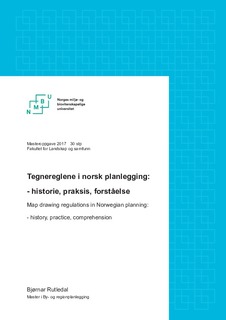| dc.contributor.advisor | Grønning, Marius | |
| dc.contributor.author | Rutledal, Bjørnar | |
| dc.coverage.spatial | Norway | nb_NO |
| dc.date.accessioned | 2017-09-19T12:25:57Z | |
| dc.date.available | 2017-09-19T12:25:57Z | |
| dc.date.issued | 2017 | |
| dc.identifier.uri | http://hdl.handle.net/11250/2455513 | |
| dc.description.abstract | Denne oppgaven tar for seg tegnereglene i norsk planlegging og forsøker å svare på hvorvidt de er tilpasset dagens plansystem. Hensikten er ikke å svare et enkelt ja eller nei på dette, men å bidra til en diskusjon rundt det norske plansystemet. Oppgaven har vært veiledet som en del av forskningsgrunnlaget for den pågående evalueringen av plan- og bygningsloven, plandelen, dvs. NFR-prosjektet EVAPLAN 2008.
Planlegging etter loven skal fremme bærekraftig utvikling, samordning og helhetlig arealforvaltning, og skal utgjøre et institusjonelt tyngdepunkt der alle avveininger rundt arealbruk blir gjort. Med tegneregler menes her de bestemmelser i lov og kartforskrift som regulerer framstillingen av plankart. Spørsmålet er om reglene for kartframstilling er tilpasset de utfordringene planlegging står overfor i dagens samfunn, slik loven definerer dem.
Oppgaven tar for seg dagens og tidligere lover som regulerer prosedyrer og produkter innen planlegging for å se hvordan plankart og tegnereglene har utviklet seg over tid. I tillegg gjennomføres en caseanalyse av Drammen for å belyse hvordan kommunen forholder seg til regulerte framstillinger som plankart og hvilke andre framstillinger og beskrivelsesmåter som benyttes for å styre en omstilling og en transformasjon.
Plankartet har flere roller i dagens samfunn. Den ene er å produsere juridisk bindende avklaringer om arealforvaltning, noe som krever en entydig framstilling. Samtidig skal plankartet også fungere som en informasjonskilde for å gi allmennheten, markedsaktører og offentlige sektormyndigheter innsyn og innflytelse gjennom medvirkningsprosesser og høringer. Disse rollene som et plankart kan ha krever ofte ulike framstillingsmåter, som kan være motstridende.
Dagens tegneregler har vokst frem i et plansystem med fokus på juridiske funksjoner i planleggingen, regulering av arealer, og gjenspeiler det i måten planinnholdet blir framstilt på. Den juridiske funksjonen kan gå på bekostning av lesbarheten, og dermed komme i konflikt med rollen som informasjonskilde for mennesker uten faglig kompetanse innen planlegging. Caset viser at for å oppnå den nødvendige informasjonsflyten, tar man gjerne i bruk alternative framstillingsmåter som ligger utenfor lovverket, som illustrasjoner, konseptskisser, prosjekttegninger, strategiske diagrammer og temakart. Disse erkjennelsene peker ikke bare på tegnereglene, men på behovet for bevissthet om hvilken rolle framstillinger spiller i planlegging, utover regulerte minstekrav og rammer for kartframstilling. | nb_NO |
| dc.description.abstract | This thesis explores the rules for map drawing in the Norwegian planning system in an attempt to determine whether they are suited for today’s planning needs. The purpose is not to answer a clear yes or no to this, but rather to contribute to an ongoing discussion regarding the Norwegian planning system. The guidance for this thesis has been part of the research foundation for the ongoing evaluation of the planning section in the Planning and Building Act, i.e. the NFR-project EVAPLAN 2008.
Planning under the law shall promote sustainable development, coordination and comprehensive land management and constitute an institutional hub where all decisions regarding land-use are taken. The drawing rules are defined in this thesis as the rules for map presentations existing in the Planning and Building Act and in the Map and Planning Regulation. The question is whether these rules for map drawing are able to face the challenges of planning in today's society, as defined by law.
The thesis analyses current and previous laws that regulate procedures and products in planning to see how planning maps and its drawing rules have evolved over time. In addition, a case study of the municipality of Drammen is conducted to gain insight into how the municipality deals with these rules and what other forms of representations and methods of description they use.
The planning map plays several roles in today's society. Firstly, its purpose is to produce legally binding clarifications of land use management, which requires an unambiguous and clear presentation. At the same time, the planning map also serves as a source of information in providing the public, marked actors and sectoral authorities with insight and influence through participation and consultation processes. These different roles a planning map can play, often demand different methods of presentation, which can be contradictory.
Today's drawing rules have evolved in a planning system with focus on legal functions, the regulation of land use, and reflect this in the way planning maps are presented. This regulatory function can come at the expense of readability and thereby compromise the role as a source of information for people without professional competence in planning. The case study shows that in order to achieve satisfactory flows of information, different methods of presentation are used, such as illustrations, concept sketches, project drawings, strategic diagrams and thematic maps. These realizations points not only to the drawing rules, but to the need for consciousness regarding which role presentations play in planning, outside regulated minimum requirements and frames of map presentations. | nb_NO |
| dc.language.iso | nob | nb_NO |
| dc.publisher | Norwegian University of Life Sciences, Ås | nb_NO |
| dc.rights | Attribution-NonCommercial-NoDerivatives 4.0 Internasjonal | * |
| dc.rights.uri | http://creativecommons.org/licenses/by-nc-nd/4.0/deed.no | * |
| dc.subject | Drammen | nb_NO |
| dc.subject | Tegneregler | nb_NO |
| dc.subject | Plansystem | nb_NO |
| dc.title | Tegnereglene i norsk planlegging : historie, praksis, forståelse | nb_NO |
| dc.title.alternative | Map drawing regulations in Norwegian planning : history, practice, comprehension | nb_NO |
| dc.type | Master thesis | nb_NO |
| dc.description.version | submittedVersion | nb_NO |
| dc.subject.nsi | VDP::Samfunnsvitenskap: 200::Urbanisme og fysisk planlegging: 230::Planleggingshistorie, -teori og -metodikk: 231 | nb_NO |
| dc.source.pagenumber | 96 | nb_NO |
| dc.description.localcode | M-BYREG | nb_NO |

